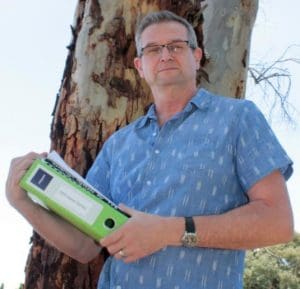
NSW Department of Primary Industries senior research scientist, Dr Steve McLeod.
RANGELAND goat numbers have fallen 40 percent in New South Wales in the past year, according to a New South Wales Department of Primary Industries report.
The NSW Department of Primary Industry today said goat industry data in a report analysing rangeland goat population figures showed numbers have declined from a record high of 5.7 million in 2016 to 3.4 million in 2017.
The NSW Department of Primary Industries report is based on figures from the Office of Environment and Heritage 2017 aerial survey of central and western NSW, and has confirmed goat industry observations on the ground.
Goat Industry Council of Australia president, Rick Gates, said the report reflected industry expectations. And the population data highlighted the need to increase managed goat numbers.
“From my observations I expected numbers to be down by 20 or 30 percent, so I wasn’t surprised.
“On a positive note, NSW DPI is working closely with industry and these results build goat industry confidence in the data collection, which is used by the newly-formed Goat Industry Forecasting Committee,” Mr Gates said.
Stabilisation of the goat supply base is recognised as a critical success factor under the industry’s strategic plan out to 2020.
Mr Gates puts the population decline to more harvesting when prices reached 750c/kg last year, then dropped sharply to 480c/kg as stocks in US cold storage increased and have recovered recently to 540c/kg.
“The money was there and people harvested.
“But 750c/kg, I don’t think it did the industry any favours.”
Mr Gates said an industry priority was still to increase managed goat numbers and the strategic plan clearly outlined that.
The Goat Industry Forecasting Committee was created through a Meat & Livestock Australia and NSW DPI co-funded project, the committee aims to improve industry’s understanding of projected goat populations and supply changes.
NSW DPI senior research scientist and report author, Steven McLeod, said updated survey techniques and modern technology have boosted the accuracy of results.
“Digital technology has replaced pen and paper – in 2016 we updated the system used since goats surveys began in 1992 with modern survey design.
“We are confident the new methods are reliable, OEH data collection is of a high standard and results are accurate with greater precision in indicating population changes,” he said.
Dr McLeod said the reason for the population decline is unclear and further work was needed to build a better understanding of goat population dynamics and factors influencing changes.
“Dry seasonal conditions and the unprecedented high goat population in 2016 could help explain the population decline this year,” he said.
“We had reports of poor reproduction in sheep and goat herds and the results may be influenced by goat paddock distribution, stocking rates and the timing of large, efficient goat harvesting operations in the survey zone.
In 2018, a program of continuous improvement will boost operator safety by using blocks rather than long transects may also allow scientists to investigate goat management factors influencing aerial survey counts.
Source: NSW DPI.



HAVE YOUR SAY